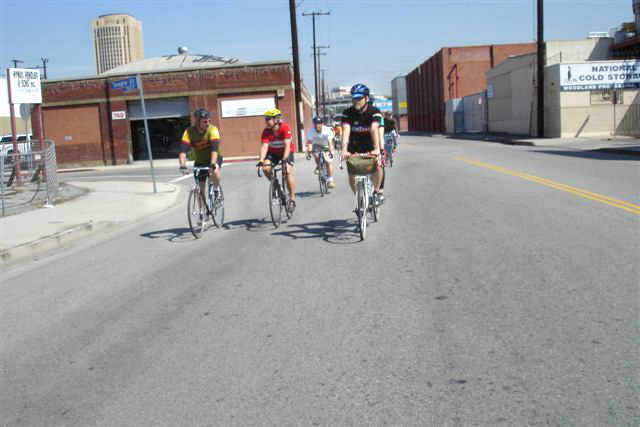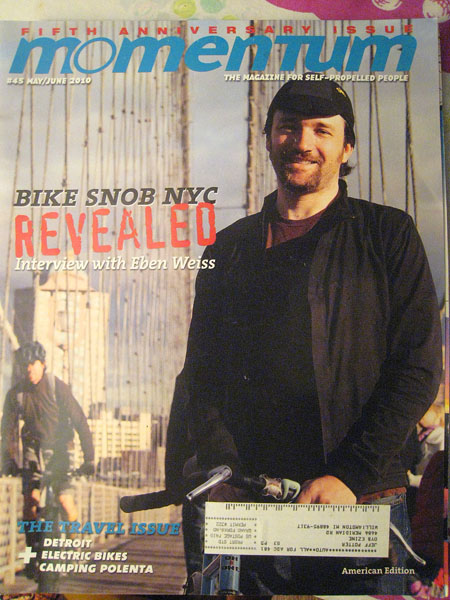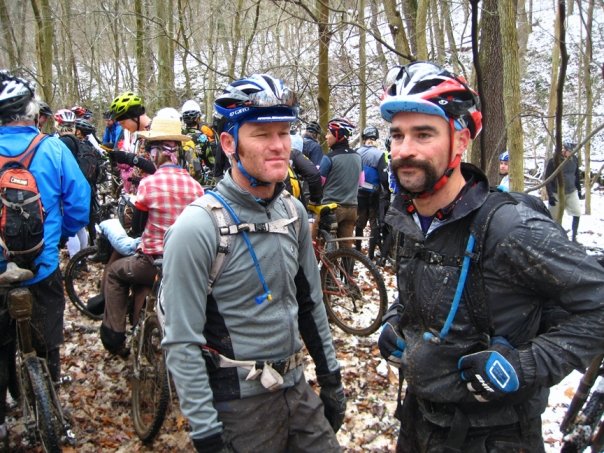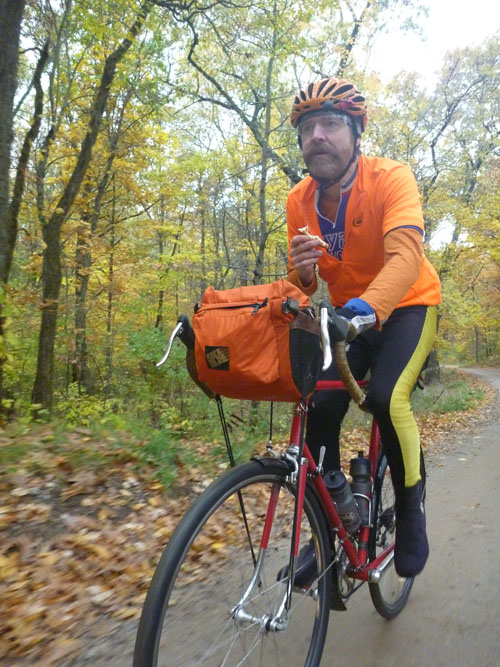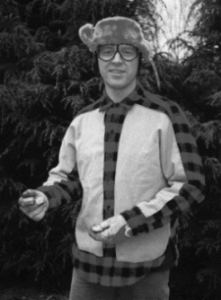Ride Report: Stitching the River
by Richard Risemberg (Los Angeles, August 2006)
[article reprinted from the Bicycle Fixation website]
I live in the Miracle Mile district of Los Angeles, near the County
Museum of Art, so I headed up 6th St. through Koreatown and all the
stacked and crowded two-story streetfront shops housing dentists,
acupuncturists, florist, tofu houses, herb clinics, and so forth, up
and down the rolling hills leading to downtown. A little east of
Vermont Ave. the ethnic mix switches to Central American, and the
streetscape now incorporates tiny storefront churches, pupuserias,
small-time lawyers, and residential hotels–but the rolling hills
continue apace.
I pass by MacArthur Park with its picnicking families and its
notorious sellers of false IDs, its pushcart vendors, its balloons
and laughing kids, crest a few more rolling hills, and finally come
to the Harbor Freeway, the western border of downtown, where a
steeply-descending S-curve requires me to use the fixie’s front brake
for the first time that morning.
Downtown is tall buildings shadowing the busy streets, newer glass
towers alternating with ornate Art-Deco hotels and lofts and who
knows what–the LA Cultural Affairs department has a stunning office
in a marble and mahogany building with an ornate grill gracing the
entire frontage. Left on Broadway takes me through a cacophony of
Mexican and Salvadoran loudspeakers and families cruising the
hundreds of tiny, glittering shops selling jewelry, fancy dresses,
boom boxes, cell phones, TVs, and damn near everything else. I dodge
the buses and trucks and cop cars and pushcarts and shopping carts
and crest another hill by the courthouse district, and finally roll
down into Chinatown.
Chinatowns the world over manage to be both dingy and bright, lively
and grim, smog-fouled storefronts bearing vivid red and gold neon and
plastic signs, stern-faced Chinese scurrying purposefully in drab
clothes, always busy, usually serious. I pulled into a little alley
by the Phoenix Bakery (whose cakes are unsurpassable) and found the
little hole-in-the-wall dim sum shop, nearly invisible behind a row
of dusty SUVs. I picked up some goodies to bring home to the wife,
threw them in the messenger bag, and squirreled back out onto
Broadway, headed for the bridge over the LA River.
You can see the Los Angeles River as pathetic or as terrifying, for
it usually bears almost no water and is almost entirely encased in
concrete. To me, it’s a monumental sculpture, and while I agree with
the community’s plans to green the river, I’ll miss its sculptural
aspects if we are ever fortunate enough to succeed. For now, it is a
study in minimalism: from downtown to the sea it ranges between 20
and 100 meters wide and about ten meters deep, pale white concrete
unadorned except for graffiti, strutting pigeons, and a narrow deeper
channel in the center where the water stays most of the year. (In
winter storms it can fill to the banks in a few minutes.) Tributary
channels swoop in from the side, streamlined into the main channel,
and lesser drains open up as simple holes in the hard walls, or hide
behind heavy iron sluice gates which open from the relentless
pressure of stormwater when the skies rage in January. On either side
run busy railroad tracks, and a long file of steel power pylons and
the catenaries of high-tension lines mark the path of the river in
the sky long after you can no longer see its banks in the distance.
Between the tracks and the river, dust and weeds; beyond the tracks,
rusty corrugated walls of factories, warehouse, and junkyards. And
the bridges: the justly-famous bridges of downtown, built mostly in
the 1930s, elegant leaping arches decorated with elaborate lampposts
and guardrails, concrete made into civic poetry in a era that was
learning to love itself again after the Depression.
Looking downriver from the Broadway Street bridge, I decided (at
last) on my route for the day: I would ride all of the downtown
bridges, from Broadway to Olympic Boulevard, zigzagging back and
forth across the great gray gulf like a line of stitching.
The river wasted no time giving me a workout: no sooner was I over
the Broadway bridge than I turned back nearly 180 degrees and crossed
the river again on the Spring Street span, looking to my right to see
the bridge I had crossed just a minute before. Once back on the west
bank, I turned between a row of cinderblock warehouses to north Main
Street and crossed, again almost immediately, on a level bridge
leading to, of all things, an active winery and one of the first
artist’s loft developments in LA…sharing the neighborhood with a
concrete plant, a notoriously deadly housing project, and a sprawl of
blank-faced warehouses abutting the multimodal yard where cargo comes
off trains and onto trucks, and off trucks and onto trains. A dip
under the freeway, another brief climb, a turn to the right, and I’m
off in search of the next bridge.
Now, the east bank of the river is a bluff, considerably higher than
the west bank, so after climbing the arch of the bridge and easing
down the descent to the east bank, I would face another climb almost
immediately–and in the manner of LA streets, the roadway just goes
straight up the face of the bluff, without angling to ameliorate the
steepness in any way. But my trusty Fuji fixie magically allowed me
to scale the walls with only a bit of grunting and standing on the
pedals. So up and down I went, over the bridges then up the bank–and
of course the blufftop road often dipped up and down as well,
swerving by parks and ponds, cruising through clapboard
neighborhoods, winding between the looming, shabby walls of the
warehouse district. I saw plenty of stunning buildings: old brick
sheds built in the days when even warehouses merited a few curlicues
along the roofline and a hand-painted sign, or concrete structures
built when the material was novel and architects loved to play with
its plasticity.
One long bridge left the bluff at its height and traversed not only
the river itself but a railyard and about two square miles of
warehouses, passing them all well above roof level; in the distance
blue mountains slouched under puffy drifting clouds. And always the
river, broad and white and dirty and empty and grand, with train
tracks and powerlines wound around it like demented jewelry, and the
little squirmy specks that were my fellow humans inching tediously
within or along it on this sunny Sunday noon.
Finally I got to Oympic Boulevard by the gigantic ancient Sears
building (one of the few left, I hear), and headed west towards home.
Olympic cuts through the festive clutter of the garment district and
by Santee Alley, where hundreds of open-front shops line the streets
and the alley itself (which really is just an alley, for pedestrians
only), and the odors of roasted corn and fresh-made salsas fill the
air. Zipping wearily out of downtown, passing the Staples Center and
then under the Harbor Freeway once again, I was soon back in
Koreatown, then the residential flats of Wilshire West, then La Brea
Avenue and home.
Hot, sweaty, exhausted, and happy. Not many miles–maybe thirty?–but
lots of hillclimb sprints, too much to see, too much to remember to
go back to. A grand day, a grand ride indeed. –Richard Risemberg
========================================================================
Stitching the River Ride, Redux October 22, 2006
A few weeks ago I posted an article about a ride I took one Sunday,
riding all of downtown Los Angeles’s bridges between Broadway and
Olympic boulevards. Last Sunday I repeated it, this time with about
twenty other riders along, including a few members of the L. A.
Wheelmen, and the indomitable Chuck Schmidt of Velo-Retro, riding an
immaculate black Waterford fixie. (But all of Chuck’s bikes are
immaculate.)
We wandered back and forth between the Eastside bluff and the
warehouse district, past the San Antonio Winery and the Brewery lofts
(one of the first factory-to-lofts conversions in LA, and still an
artists’ colony), over, around, and under a variety of delightful Art
Deco bridges, between rows of loading docks, past busy alleys, past
hilly parks complete with ponds and resident ducks, and through leafy
neighborhoods cluttered with clapboard bungalows and gang graffiti.
At one point we came to a bridge that had been closed for filming,
but a friendly motorcycle cop escorted us across the bridge and
through the set–where the grips dropped their work to take pictures
of the parade of bicycles.
At the last stop, on the Olympic Boulvaqrd bridge just past the old
Art Deco Sears, Roebuck, & Co. building, one woman commented that
she’d lived in LA all her life and had never seen so much of the city
as she had that day! Not bad for a twenty-mile ride, and a testament
to the power of the bicycle for revealing our world and our
communities to us.
Glad to report that only a tiny minority of riders drove to the start
of the ride. Most rode their bikes, and a last group of six of us
headed west after some tasty Chinese pastries by the statue of Sun-
Yat Sen, riding together to the Miracle Mile area, where we all
finally parted ways. –Richard Risemberg
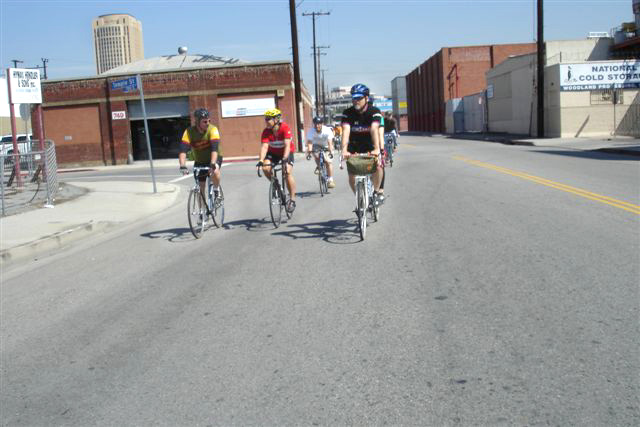
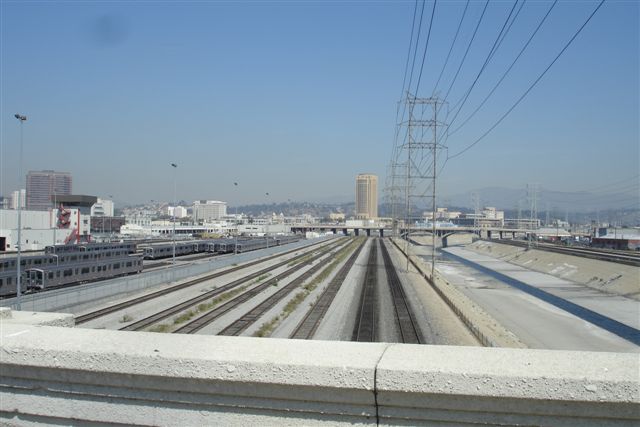
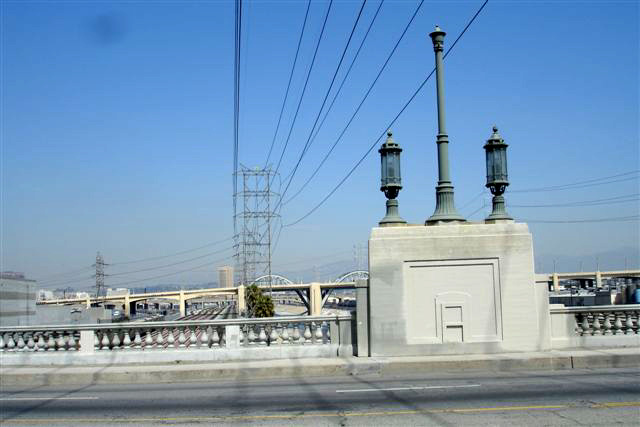
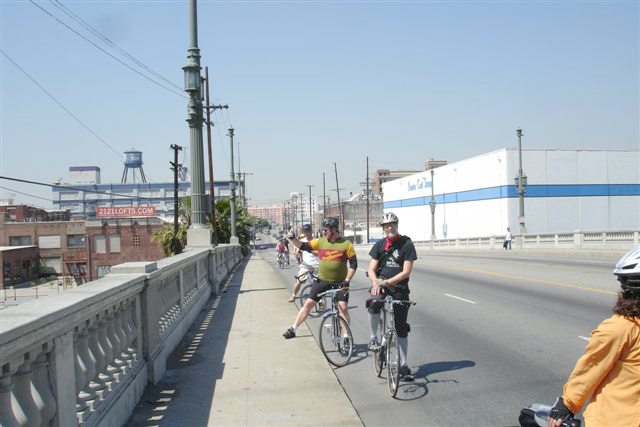
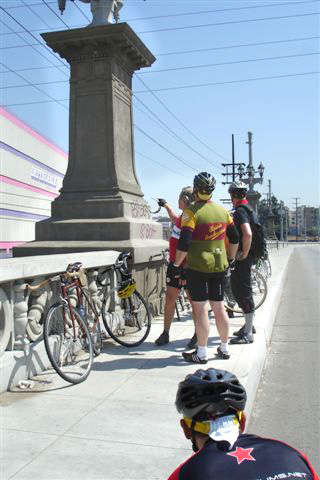
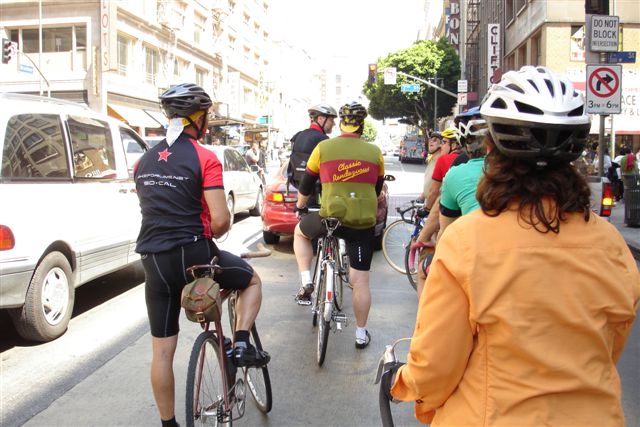
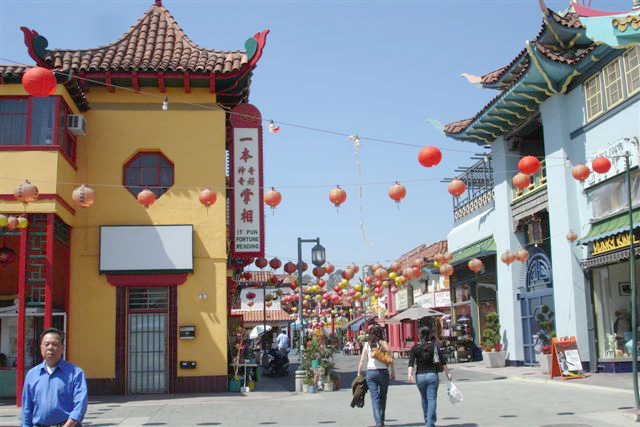
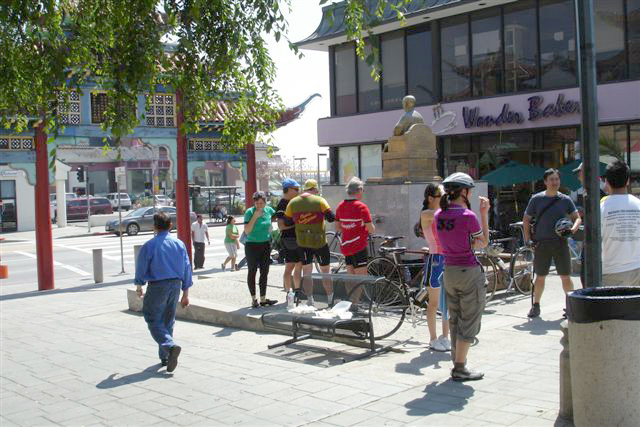
https://www.bicyclefixation.com
